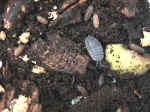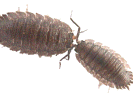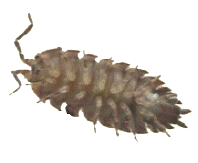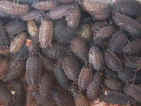Habitat and Behaviour
Habitat
In Christchurch, New Zealand, these woodlice are found in cool, humid damp conditions. They are most easily found in spring and autumn. The most common site around the home is on compost heaps or under shelter such as bark and boards left in shaded, moist conditions. They may also be found in deep, damp soil litter under the shelter of bushes or trees.
High summer temperatures (up to 32 degrees C) cause the woodlice to retreat deeper into shelter making them more difficult to locate. The cooler winter temperatures (down to -5 degrees C) also cause them to retreat further into shelter.
Behaviour
 Many of the behavioural responses of
woodlice are concerned with water conservation and the need to avoid desiccation. Most
woodlice are terrestrial (most other crustacea are aquatic), however they lack some of the
structures found in other terrestrial arthropods such as insects and spiders.
Many of the behavioural responses of
woodlice are concerned with water conservation and the need to avoid desiccation. Most
woodlice are terrestrial (most other crustacea are aquatic), however they lack some of the
structures found in other terrestrial arthropods such as insects and spiders.
Woodlice have a relatively high surface area to volume ratio and are therefore likely to loose water by diffusion more quickly than many other species. They also lack a waxy, waterproof cuticle and so water will readily diffuse through their exoskeleton more rapidly than in other arthropods.
 |
Their respiratory surfaces are simple pseudo-lungs with a pore opening to the outside to allow exchange of gases in and out of the lung. This pore is unable to be closed and so water is able to continuously diffuse (or transpire) from the inner surface of the psuedo-lung out into the surroundings. |
| Ventral view - the whitish spot toward the rear end is one of the "lungs" |
To replace water lost by transpirational losses, woodlice are able to take up water through their uropods. These structures are pressed against moist surfaces, capillary action results in water absorption.
The behaviour of the woodlice helps it to prevent excessive water loss and so it is able to successfully live in a range of terrestrial habitats.
1. Humidity
Porcellio scaber show a kinesis type responses to humidity. They show both an increased speed of movement (=orhtokinesis) and increased rate of turning (=klinokinesis) in dry conditions and slower rates of movement in more humid conditions. This response will result in them accumulating in more humid regions.
These responses mean that the animals will spend more time in humid conditions and so will not loose water from their bodies.
It has been reported (Sutton, Woodlice, 1972) that woodlice taken from very damp conditions show a different reaction. They may either show no difference in their reaction to changes in humidty or may even actively avoid the humid regions in preference for the drier regions. We have observed differences in behaviour of woodlice after varying lengths of time in dry conditions which would support this.
2. Temperature
Woodlice show a positive orthokinesis (speed of movement) as the temperature increases or decrease from their preferred value. Their rate of turning also seems to show a similar response.
By moving more rapidly they are likely to spend less time in these unfavourable conditions and therefore will avoid unnecessary desiccation.
3. Light
Woodlice show a negative phototaxis.This would will result in them moving away from bright conditions towards darker regions. Brighter conditions tend to be drier and warmer than dark conditions so this behaviour will again result in decreased desiccation.
4. Other objects
Woodlice show a positive thigmokinesis. This means they are less active when more of their body surface is in contact with other objects (including other woodlice). They will move around so that the maximum amount of their body is in contact with other objects.
This behaviour results in woodlice forming groups or clumps and also means they will tend to congregate in cracks and crevices. In all these cases they will have better protection from desiccation and also predators.
![]()
![]()
![]()
![]()
![]()
